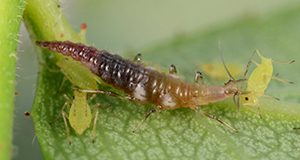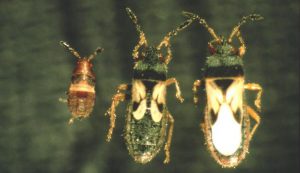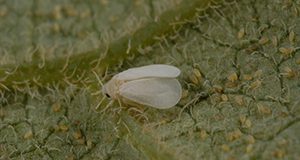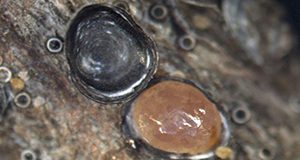Pest control professionals and homeowners throughout Florida and the southeastern US are seeking effective options that are safer for people and the environment than some conventional synthetic pesticides. There is also rising interest in organic gardening, which relies on natural pesticides. This 13-page fact sheet describes natural products for use in residential landscapes and gardens. Written by Matthew A. Borden, Eileen A. Buss, Sydney G. Park Brown, and Adam G. Dale, and published by the UF/IFAS Department of Entomology and Nematology, revised September 2018.
http://edis.ifas.ufl.edu/in197
Tag: Eileen A. Buss
Managing Southern Chinch Bug in Warm Season Turfgrasses
Southern chinch bug, Blissus insularis Barber, is the most damaging insect pest of St. Augustinegrass in the United States. St. Augustinegrass is the most common turfgrass used in Florida. The ubiquity of this single turfgrass species makes southern chinch bug an economically important pest in the state. In fact, chinch bugs cost Florida homeowners and professionals millions of dollars every year. This 7-page fact sheet written by Eileen A. Buss, Brianna M. Whitman, and Adam G. Dale and published by the UF/IFAS Department of Entomology and Nematology describes the biology of the pest and the damage it causes and lists ways to scout and monitor for chinch bugs and some strategies for control of the pest.
http://edis.ifas.ufl.edu/lh036
Managing Whiteflies on Landscape Ornamentals
Whiteflies are a common pest of many ornamental plants throughout Florida and the world. There are more than 1,500 species worldwide and over 75 reported in Florida. Although infestation does not always require treatment, it is important to be able to identify and monitor for these pests for effective integrated pest management. This 8-page fact sheet written by Eileen A. Buss, Catharine Mannion, Lance Osborne, and Adam Dale and published by the Entomology and Nematology Department describes whitefly species, their identification and biology, the damage they cause, and best management practices to control them and still maintain healthy populations of natural enemies and other beneficial insects.
http://edis.ifas.ufl.edu/mg254
Managing Scale Insects on Ornamental Plants
Scale insects are a diverse group of piercing-sucking pests (Hemiptera) commonly found on ornamental plants in landscapes and nurseries. There are over 180 species of scale insects in Florida, but only a small percentage are important pests of ornamental plants. They damage plants and secrete a waxy covering that makes them difficult to control using most chemical control measures. This 7-page fact sheet written by Eileen A. Buss and Adam Dale and published by the Department of Entomology and Nematology differentiates between armored and soft-scale insect pests and lists common types of each, provides information about the biology of scale insects and how to identify them and the damage they cause, describes how to scout and monitor for scale insects, and lists several methods for prevention and control of scale insect invasions.
http://edis.ifas.ufl.edu/mg005
Insect Pest Management on Turfgrass
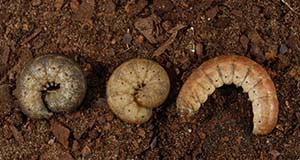
Turfgrass is grown in many environments and for different uses, including home lawns, parks, athletic fields, cemeteries, golf courses, sod farms, pastures, and right-of-ways. The intensity of turfgrass insect management largely depends on the turf species, variety, and its intended use. This eighteen-page fact sheet describes how to manage a variety of insect pests including armyworms, bermudagrass mite, cutworms, fire ants, ground pearls, hunting billbug, mole crickets, scales/mealybugs, southern chinch bug, twolined spittlebugs, tropical sod webworm, and white grubs. Written by Eileen A. Buss and Adam G. Dale, and published by the Entomology and Nematology Department.
http://edis.ifas.ufl.edu/ig001
Natural Products for Managing Landscape and Garden Pests in Florida
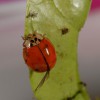 This publication describes “natural” pesticides: alternatives that are usually less toxic to non-target organisms and the environment and that, when used correctly, can be effective substitutes for synthetic products. In this publication, natural substances used for pest management in landscapes and gardens are grouped into oils, plant extracts, insecticidal soaps, mineral insecticides, microbial insecticides, and products that control diseases. Certain products contain combinations of these groups (e.g., soap and oil). This 8-page fact sheet was written by Eileen A. Buss and Sydney G. Park Brown, and published by the UF Department of Entomology and Nematology, April 2014.
This publication describes “natural” pesticides: alternatives that are usually less toxic to non-target organisms and the environment and that, when used correctly, can be effective substitutes for synthetic products. In this publication, natural substances used for pest management in landscapes and gardens are grouped into oils, plant extracts, insecticidal soaps, mineral insecticides, microbial insecticides, and products that control diseases. Certain products contain combinations of these groups (e.g., soap and oil). This 8-page fact sheet was written by Eileen A. Buss and Sydney G. Park Brown, and published by the UF Department of Entomology and Nematology, April 2014.
http://edis.ifas.ufl.edu/in197
Mole Cricket IPM Guide for Florida
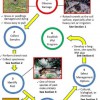 Mole crickets can become serious pests of turfgrasses, pastures, and vegetable seedlings. The first step in determining if you have a mole cricket problem at a site is to compare the existing damage to pictures of known mole cricket damage. If the damage is likely caused by mole crickets, specimens should be obtained and the pest identified. You then should determine if the number of mole crickets is great enough to cause an unacceptable level of damage and decide what control measures should be used. Eventually, a long-term, sustainable integrated pest management (IPM) program should be established. This 20-page guide will help you identify mole cricket infestations and manage them effectively and economically while minimizing environmental impacts. Written by C. R. Kerr, N. C. Leppla, E. A. Buss, and J. H. Frank, and published by the UF Department of Entomology and Nematology, May 2014.
Mole crickets can become serious pests of turfgrasses, pastures, and vegetable seedlings. The first step in determining if you have a mole cricket problem at a site is to compare the existing damage to pictures of known mole cricket damage. If the damage is likely caused by mole crickets, specimens should be obtained and the pest identified. You then should determine if the number of mole crickets is great enough to cause an unacceptable level of damage and decide what control measures should be used. Eventually, a long-term, sustainable integrated pest management (IPM) program should be established. This 20-page guide will help you identify mole cricket infestations and manage them effectively and economically while minimizing environmental impacts. Written by C. R. Kerr, N. C. Leppla, E. A. Buss, and J. H. Frank, and published by the UF Department of Entomology and Nematology, May 2014.
http://edis.ifas.ufl.edu/in1021
Minimizing Honey Bee Exposure to Pesticides
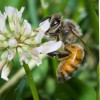 Protecting honey bees and other pollinators from pesticide impacts is important to the sustainability of agriculture. Consequently, pesticide applicators must determine if there is a clear hazard to managed or wild populations of bees. Potential exposure of bees to pesticides can vary greatly depending on the type of pesticide, formulation, application method, label restrictions, and other factors. The goal in using a pesticide is to achieve maximum benefit (success) with minimum negative impact, and these factors should always be considered in pesticide selection. This publication is written (1) to help assure the sustainability of both bees and agriculture by informing beekeepers, pesticide users, and the general public about the often complex relationship between pollinators (specifically bees) and pesticides, (2) to offer guidance for improved communication between beekeepers and pesticide users, (3) to offer pollinator risk-reducing strategies for growers and other applicators when using pesticides, and (4) to provide clarity in laws, labeling, and associated definitions. This 14-page fact sheet was written by J. D. Ellis, J. Klopchin, E. Buss, F. M. Fishel, W. H. Kern, C. Mannion, E. McAvoy, L. S. Osborne, M. Rogers, M. Sanford, H. Smith, P. Stansly, L. Stelinski, and S. Webb, and published by the UF Department of Entomology and Nematology, March 2014.
Protecting honey bees and other pollinators from pesticide impacts is important to the sustainability of agriculture. Consequently, pesticide applicators must determine if there is a clear hazard to managed or wild populations of bees. Potential exposure of bees to pesticides can vary greatly depending on the type of pesticide, formulation, application method, label restrictions, and other factors. The goal in using a pesticide is to achieve maximum benefit (success) with minimum negative impact, and these factors should always be considered in pesticide selection. This publication is written (1) to help assure the sustainability of both bees and agriculture by informing beekeepers, pesticide users, and the general public about the often complex relationship between pollinators (specifically bees) and pesticides, (2) to offer guidance for improved communication between beekeepers and pesticide users, (3) to offer pollinator risk-reducing strategies for growers and other applicators when using pesticides, and (4) to provide clarity in laws, labeling, and associated definitions. This 14-page fact sheet was written by J. D. Ellis, J. Klopchin, E. Buss, F. M. Fishel, W. H. Kern, C. Mannion, E. McAvoy, L. S. Osborne, M. Rogers, M. Sanford, H. Smith, P. Stansly, L. Stelinski, and S. Webb, and published by the UF Department of Entomology and Nematology, March 2014.
http://edis.ifas.ufl.edu/in1027
Whiteflies on Landscape Ornamentals (ENY317/MG254)
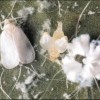 Whiteflies are common pests on many ornamental plants. Some of the most economically important species in Florida are the silverleaf whitefly, fig or ficus whitefly, citrus whitefly, and the rugose spiraling whitefly. The most frequently attacked plants include allamanda, avocado, chinaberry, citrus, fig, fringe tree, gardenia, gumbo limbo, ligustrum, mango, various palms, persimmon, viburnum, and many annuals. This 4-page fact sheet was written by E. A. Buss, and published by the UF Department of Entomology and Nematology, March 2013.
Whiteflies are common pests on many ornamental plants. Some of the most economically important species in Florida are the silverleaf whitefly, fig or ficus whitefly, citrus whitefly, and the rugose spiraling whitefly. The most frequently attacked plants include allamanda, avocado, chinaberry, citrus, fig, fringe tree, gardenia, gumbo limbo, ligustrum, mango, various palms, persimmon, viburnum, and many annuals. This 4-page fact sheet was written by E. A. Buss, and published by the UF Department of Entomology and Nematology, March 2013.
http://edis.ifas.ufl.edu/mg254
Florida Wax Scale, Ceroplastes floridensis Comstock (EENY510/IN913)
 The Florida wax scale, Ceroplastes floridensis Comstock, is one of the most commonly encountered soft scales throughout the the southern United States, where it is a serious pest of citrus and several ornamental and landscape plants, like holly.This 4-page fact sheet was written by Shweta Sharma and Eileen Buss, and published by the UF Department of Entomology and Nematology, December 2011.
The Florida wax scale, Ceroplastes floridensis Comstock, is one of the most commonly encountered soft scales throughout the the southern United States, where it is a serious pest of citrus and several ornamental and landscape plants, like holly.This 4-page fact sheet was written by Shweta Sharma and Eileen Buss, and published by the UF Department of Entomology and Nematology, December 2011.
http://edis.ifas.ufl.edu/in913
ENY351/IN410 Insect Pest Management on Golf Courses
Revised! ENY-351, a 14-page illustrated fact sheet by Eileen A. Buss, describes the biology and management of the most
important insect pests on golf courses in Florida. Published by the UF Department of Entomology and Nematology, June 2009.
http://edis.ifas.ufl.edu/IN410
